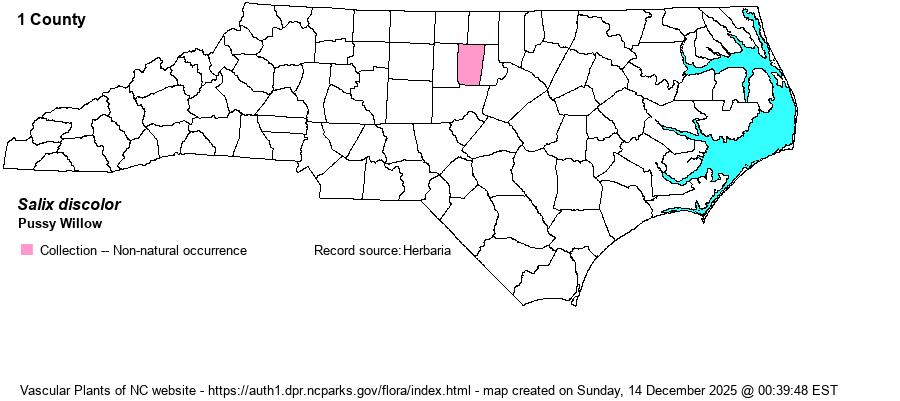| Author | Muhlenberg | |
| Distribution | Due to the long habit of treating S. discolor in the broad sense (including S. humilis and S. occidentalis), we here include only those specimens annotated by G. Argus as S. discolor. Out of 18 sheets at SERNEC, only 1 is so annotated: Orange County, Mason Farm on Morgan Creek, 1 August 1950, Eller 56 (WCUH). Argus (1986) cites this very specimen.
Native to N.A. from Lab. to B.C., south to northern VA, southern IL, CO, and ID; disjunct to NC where adventive or more likely escaped from plantings. | |
| Abundance | Very rare. | |
| Habitat | Along creek. In its native range, it is an inhabitant of wetlands, such as marshes, floodplains, fens, and wet thickets. | |
| Phenology | Flowering and fruiting March-May. | |
| Identification | Pussy Willow is a northern species that assumes a tall shrub shape. In general, mature leaf undersides are not tomentose like those of S. humilis and S. occidentalis; rather, they are glaucescent or glaucous and sparsely hairy (except perhaps the midrib which can be densely hairy). See Argus (1986) for discussion and key. | |
| Taxonomic Comments | The genus Salix is a very large and complex group of plants that vary from ground-hugging Arctic belly plants to huge trees. There are 113 species in North America alone, including introduced species. They are extremely important to browsing mammals -- rabbits, deer, elk, muskox, moose, many rodents -- and browsing birds like ptarmigan. Many birds use them to nest in. Here in NC we only have a small number of native species (5) and so do not appreciate the ecological importance of willows. We highly recommend reading the introductory pages of George Argus's FNA treatment (2010) and his excellent monograph on the willows of the southeastern U.S. (1986). The latter has drawings and descriptions of all southeastern U.S. taxa. Due to natural and horticultural hybridization, some plants will not key cleanly and you may have to compare your specimen with others verified by Argus. | |
| Other Common Name(s) | | |
| State Rank | SE | |
| Global Rank | G5 | |
| State Status | | |
| US Status | | |
| USACE-agcp | | |
| USACE-emp | | |

